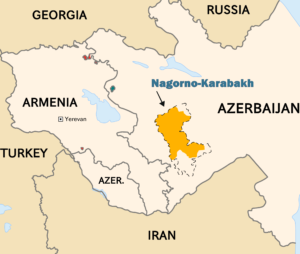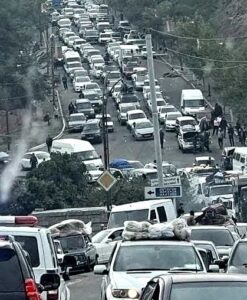Podcast: Play in new window | Download
Tens of Thousands Of Armenians Forced To Flee Their Homes
Two weeks ago, the small mountainous Republic of Artsakh was vanquished by Azeri military forces. It happened with such haste that thousands of its predominantly ethnic Armenian population had just minutes to abandon their homes.. This followed on the heels of an Azerbaijani blockade that left Armenians without food, fuel, and medicine. Artsakh has been the site of a decades-long protracted battle between Muslim and Turkish Azerbaijanis and Christian Armenians. The conflict began when Armenia and Azerbaijan were under Soviet rule. After both nations gained independence, the conflict escalated into full scale war. That war ended in 1994, with an independent Artsakh, the Armenian name for Nagorno-Karabakh, and Armenia in control of a wide swath of Azerbaijan.
Unverified reports of mass killings and rape roused fears of a repeat of the 1915 Armenian genocide by the Ottoman Empire. The first genocide of the 20th century, it was the systematic destruction of the Armenian people and identity during World War I. The genocide ended more than 2,000 years of Armenian civilization in eastern Anatolia. Along with the mass murder of Assyrian/Syriac and Greek Orthodox Christians, it enabled the creation of the Republic of Turkey. While the Turkish government denies the slaughter of Armenians was genocide, as of 2023, 34 countries have recognized the events as such.
Guest – Alex Galitsky is the Programs Director at the Armenian National Committee of America. Alex’s opinions and analysis have been published in major media outlets, including Newsweek, the Los Angeles Times, Foreign Policy, and The Hill. He has worked at the local, state, and federal levels to advance policy and legislation to protect the rights of the Armenian people nationally and internationally. ANCA Action Center
—-
National Museum of the American Latino Controversy
In 2020, Congress appropriated funding to create a National Museum of the American Latino. Last year, the Smithsonian Institution opened a temporary preview exhibition inside the National Museum of American History. The show was slated to be the largest federally funded Smithsonian exhibit on Latino civil rights history. The nation’s top Latino historians and veterans of the movement gave input. It was to feature student walkouts, school integration initiatives, and environmental and immigration activism.
Instead, it has become the focus of controversy within the Latino community over how Latinos in the United States should be portrayed. The Smithsonian has nixed the show; in its place will be an exhibit on salsa and Latin music.
That’s because Republican lawmakers and others challenge what one conservative writer described last year in The Hill as an “unabashedly Marxist portrayal of history.” Right-wing Latino political activists and Cuban-American politicians like Florida Congressman Mario Diaz-Balart voted to defund the museum.
The controversy comes as the Smithsonian is trying to raise funds to build the museum at estimated $800 million. Of this, $58 million has been raised to date.
Two historians were hired to develop the exhibit on the Latino civil rights movement of the 1960s for the museum. Felipe Hinojosa a history professor at Baylor University in Texas and Johanna Fernández, the associate professor of history at the City University of New York’s Baruch College.
Guest – Professor Felipe Hinojosa is the author of Apostles of Change: Latino Radical Politics, Church Occupations, and the Fight to Save the Barrio. His research areas include Chicana/o and Latina/o Studies, American Religion, Race and Ethnicity, and Social Movements. Prof. Hinojosa serves on the Advisory Board for the interdisciplinary, peer-reviewed, and online moderated forum Latinx Talk.
Hosted by attorney Heidi Boghosian
———————————————————




